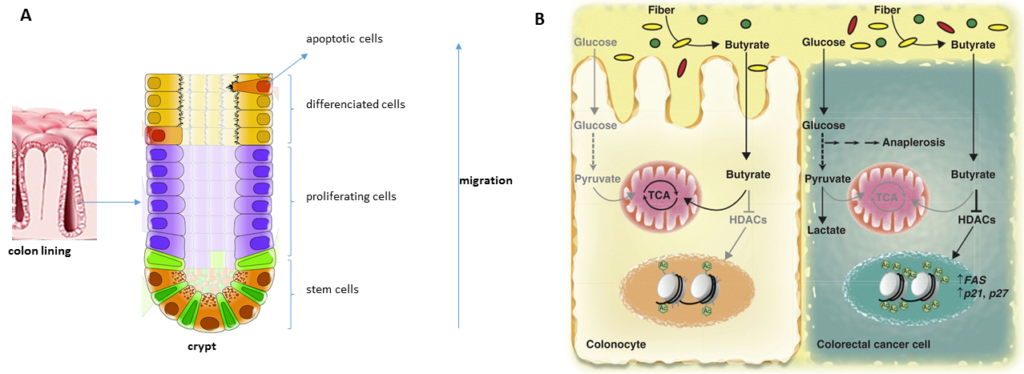Butyrate has been extensively studied in the context of colorectal cancer. It is the preferred energy source for colonocytes and its role in normal cells of the epithelium depends on its concentration and on the cell’s metabolic status.
There is a decreasing concentration gradient of butyrate from the lumen to the bottom of the crypts in the colonic lining. Cells near the lumen are exposed to higher levels of butyrate, which accumulates in the nucleus. Here butyrate acts as a HDAC inhibitor, regulating gene expression for normal events at this stage: inhibition of proliferation, induction of apoptosis and exfoliation into the lumen. In contrast, cells at the bottom are in contact with lower levels of butyrate. These cells grow and divide using butyrate as their energy source, which is transported into the mitochondria to undergo beta-oxidation. In this situation, little butyrate accumulates in the nucleus.
It has been shown that colorectal cancer cells prefer glucose over butyrate as their energy source. With extra butyrate available to cells, it accumulates in the nucleus to stop cell proliferation and promoting apoptosis by inhibiting HDACs. Specifically, hyperacetylation of histone H3 at promoter regions of genes p21, FAS and p27 leads to their upregulation and tumour growth suppression.

References
- HolscherHD. Dietary fiber and prebiotics and the gastrointestinal microbiota. Gut Microbes. 2017;8(2):172-184. Doi: 1080/19490976.2017.1290756 (Review)
- Hullar MA, Fu BC. Diet, the gut microbiome, and epigenetics.Cancer J. 2014;20(3):170. Doi: 10.1097/PPO.0000000000000053 (Review)
- Sebastián C, Mostoslavsky R. Untangling the Fiber Yarn: Butyrate Feeds Warburg to Suppress Colorectal Cancer. Cancer Discov. 2014;4(12):1368-1370. Doi:1158/2159-8290.CD-14-1231